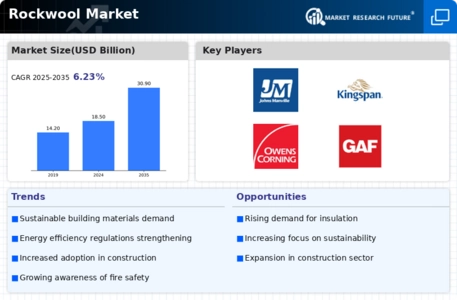Leading market players are investing heavily in the research and development in order to expand their product lines, which will help the Rockwool market grow even more. Market players are also undertaking a variety of strategic activities to spread their global footprint, with important market developments including mergers and acquisitions, new product launches, contractual agreements, higher investments, and collaboration with other organizations. To spread and survive in a more competitive and rising market climate, the Rockwool industry must offer cost-effective items.
Manufacturing locally to minimize the operational costs is one of the key business tactics used by the manufacturers in the global Rockwool industry to benefit clients and increase the market sector. In recent years, the Rockwool industry has provided some of the most significant advantages to medicine. Prime players in the Rockwool market, including Thermafiber, Inc., Rockwool International A/S, RockchatBETA, Johns Manville, Kingspan Group, Owens Corning, Paroc Group Oy, Saint-Gobin, GAF, BYUCKSAN, and others, are trying to increase market demand by investing in the research and development operations.
Rockwool International A/S is a leading global manufacturer of stone wool insulation. Headquartered in Hedehusene, Denmark, the company has grown into a key player in the insulation industry. Rockwool specializes in producing insulation solutions made from natural volcanic rock or basalt, providing products that contribute to energy efficiency, fire safety, and acoustic performance in buildings.
In October 2023, Rockwool International A/S and BASF SE partnered to develop and market a new generation of sustainable rockwool products with enhanced thermal and acoustic insulation properties. This partnership leverages BASF's expertise in polymer chemistry and Rockwool's experience in insulation materials to create innovative solutions for the construction industry.
Knauf Insulation, a leading global manufacturer of insulation materials, stands as a key player in the construction industry, providing innovative solutions for energy efficiency and sustainable building practices. Established in 1932 and headquartered in Germany, Knauf Insulation has expanded its reach to become a prominent supplier of insulation products worldwide. The company specializes in the manufacturing a diverse range of insulation materials, including glass wool, rock wool, and ecological insulating materials. Knauf Insulation is recognized for its commitment to environmental responsibility, producing insulation solutions that contribute to energy conservation and reduce carbon footprints in buildings.
In September 2023, Knauf Insulation and Saint-Gobain ISOVER signed a strategic partnership to collaborate on research and development of rockwool products for high-performance building applications. This collaboration aims to accelerate innovation and bring leading-edge insulation solutions to the market.















